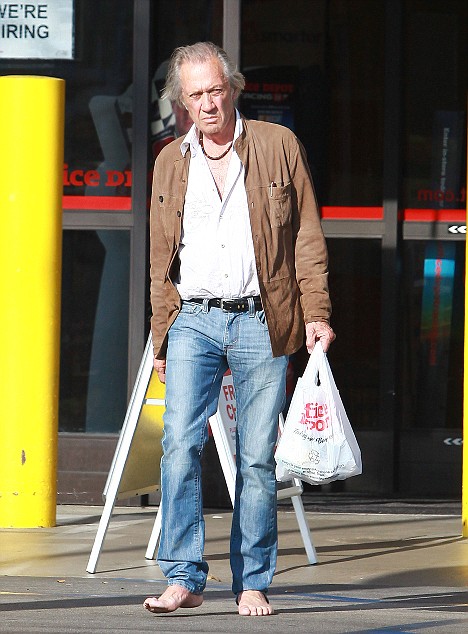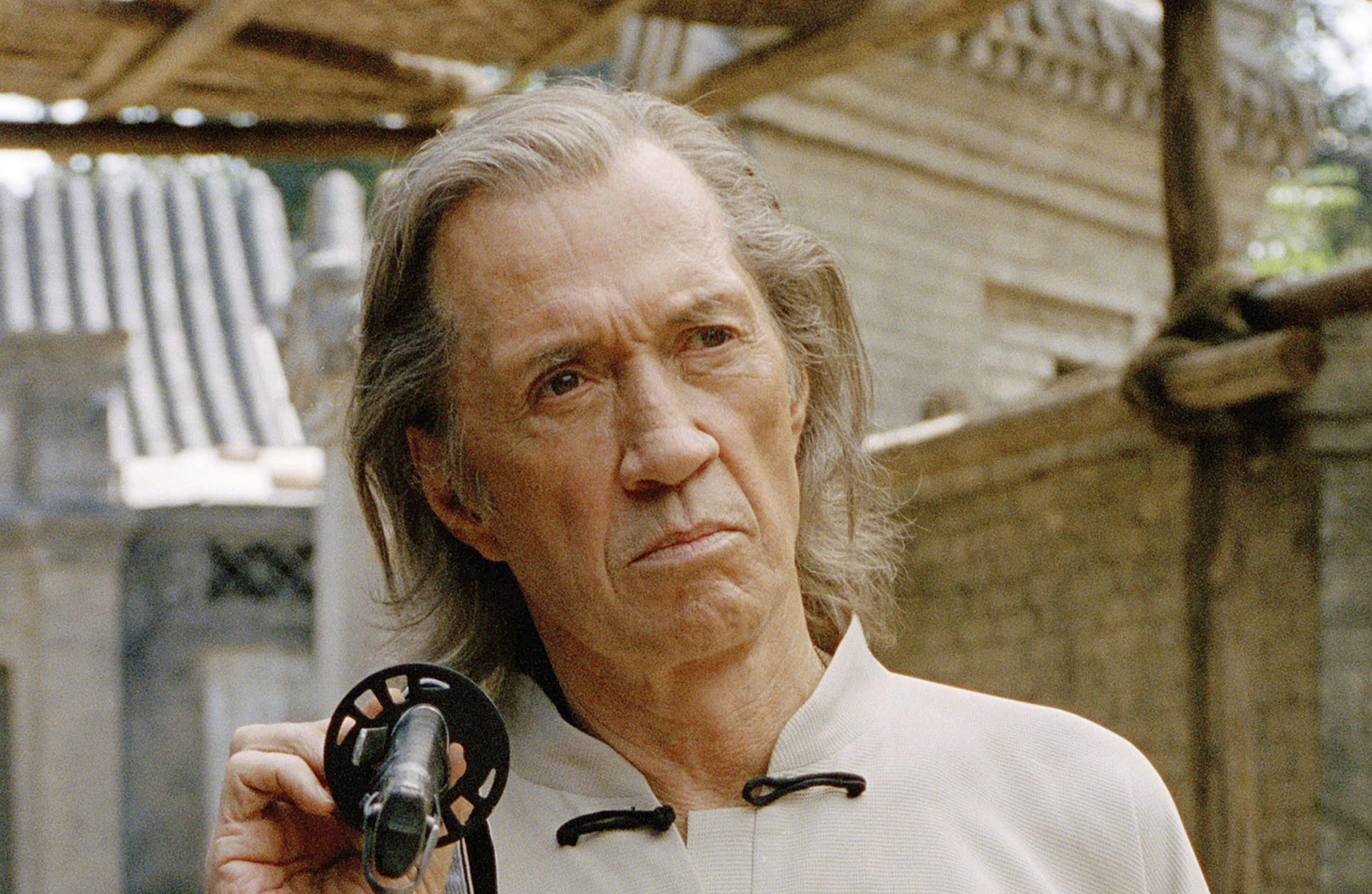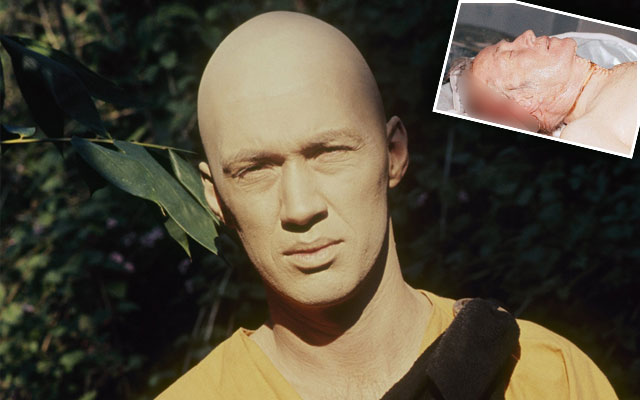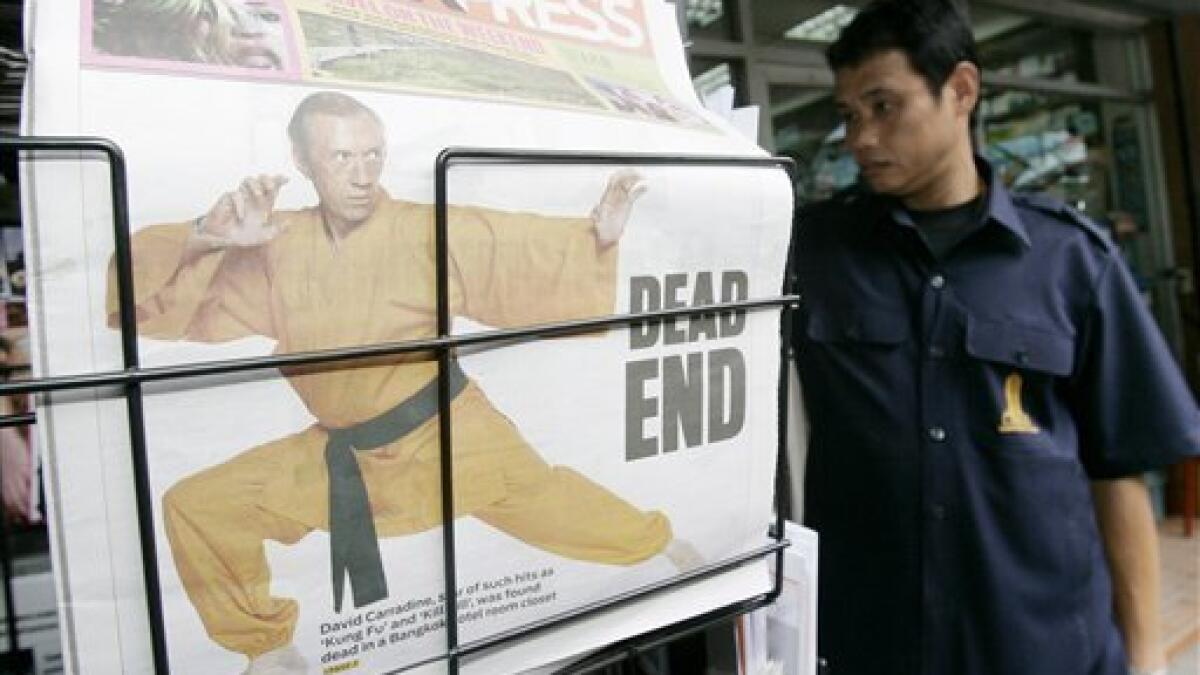Unveiling the Truth behind David Carradine Autopsy Photos
Welcome to our comprehensive collection of David Carradine autopsy photos. As one of the most influential actors in the film industry, David Carradine’s sudden and tragic death left the world in shock. In this carefully curated assortment, we provide a unique glimpse into the autopsy process, shedding light on the circumstances surrounding his untimely demise. Delve into these captivating visuals to gain a deeper understanding of the legendary actor’s final moments.
David Carradine was an American actor, musician, and martial artist who gained worldwide recognition for his iconic roles in movies and television shows. Born on December 8, 1936, in Hollywood, California, Carradine had an impressive career spanning over four decades. He was known for his diverse range of roles, including his breakthrough performance as Kwai Chang Caine in the popular TV series “Kung Fu.” However, Carradine’s life was tragically cut short, leaving behind a controversial legacy that still sparks interest to this day.
David Carradine came from a family deeply involved in the entertainment industry. He was the eldest son of John Carradine, a renowned actor known for his charismatic performances in classic films. Growing up in a household filled with creativity and ambition, David Carradine was destined to follow in his father’s footsteps and forge his own path within the world of showbiz.
Carradine’s career began on the stage, where he honed his acting skills and developed a strong passion for performance. He gradually transitioned into film and television, landing various roles in both mediums. However, it was his portrayal of the enigmatic half-American, half-Chinese Kwai Chang Caine in the television series “Kung Fu” that catapulted him to stardom. The show, which aired from 1972 to 1975, showcased Carradine’s ability to capture the essence of a martial arts master seeking spiritual enlightenment.
Content
Controversy surrounding David Carradine’s death
Tragically, on June 3, 2009, David Carradine was found dead in his hotel room in Bangkok, Thailand. The circumstances surrounding his death sparked immediate controversy and speculation. Initially believed to be a suicide, questions arose due to the suspicious nature of the incident. The investigation that followed revealed unsettling details and raised several intriguing theories surrounding the actor’s untimely demise.
Leading the investigations in Thailand, authorities discovered that Carradine had been found hanging in a closet by a rope tied around his neck. These findings prompted a closer examination of the case, which ultimately led to more questions than answers. Speculations swirled, including theories that Carradine may have accidentally caused his own death, engaged in autoerotic asphyxiation, or even fell victim to foul play.
Despite the mounting controversy, definitive conclusions about the circumstances of Carradine’s death remain elusive. Questions surrounding his final moments and the events that led to his tragic demise continue to captivate the public’s attention and fuel discussions to this day.
It is important to approach such sensitive topics with respect and empathy for the individuals involved. Although curiosity may arise, it is crucial to remember that David Carradine’s death, regardless of the circumstances, represented a profound loss for his loved ones and the entertainment industry as a whole.
Autopsy Photos
An autopsy is a medical examination performed on a deceased person to determine the cause of death. As part of this comprehensive process, autopsy photos are taken to document and record the findings. These photos serve several purposes and play a crucial role in investigations and legal proceedings.
Definition and purpose of autopsy photos
Autopsy photos, also known as post-mortem photographs, are images captured during the autopsy procedure. They depict the external and internal characteristics of the body, documenting any injuries, abnormalities, or evidence that could help determine the cause and manner of death. Autopsy photos are meticulously taken from various angles and perspectives to ensure a thorough visual account.
The primary purpose of autopsy photos is to provide a permanent visual record of the body’s condition and any pertinent findings. These photos serve as an objective and accurate portrayal of the deceased’s physical state at the time of examination. They are often used to support the conclusions reached by the medical examiner or pathologist and can be invaluable in both criminal and civil cases.
Autopsy photos may also be used for educational and research purposes. They contribute to the understanding of various diseases, injuries, and forensic techniques. These photos can aid in the advancement of medical knowledge, teaching future generations of medical professionals, and improving autopsy techniques.
The david carradine autopsy photos have brought public attention to the use of such images, highlighting their significance and the controversies that can arise. It is essential to handle autopsy photos with respect and sensitivity, ensuring they are used appropriately and professionally.
Role of autopsy photos in investigations
Autopsy photos play a crucial role in investigations, particularly in cases where the cause and manner of death are uncertain or suspicious. They provide valuable visual evidence that can help investigators and forensic experts piece together the sequence of events leading to a person’s death.
By examining autopsy photos, experts can document injuries, identify potential causes of death, and reconstruct the conditions surrounding the incident. These photos can reveal crucial details that might have been overlooked during the initial examination or might not be easily observable without an in-depth analysis.
Investigators can use autopsy photos to:
- Identify and document visible signs of trauma, such as wounds, fractures, or internal injuries.
- Estimate the time of death by examining post-mortem changes in the body.
- Verify or refute initial hypotheses about the cause of death.
- Correlate injuries with the circumstances of the incident or the statements of witnesses.
- Assist in the identification of unknown victims through dental records, facial recognition, or distinguishing marks.
- Provide visual evidence during criminal trials or legal proceedings.
The use of autopsy photos as evidence requires strict adherence to legal and ethical guidelines to protect the rights of the deceased and respect the sensitivities of the family. These guidelines vary depending on jurisdiction, but they generally ensure that the photos are only shared with those directly involved in the investigation or legal process.
Overall, autopsy photos serve a vital purpose in determining the cause of death and aiding investigations. They provide objective documentation that can corroborate or refute hypotheses and contribute to justice being served. However, it is important to handle these images with the utmost respect and ensure their use is appropriate and ethical.
David Carradine Autopsy Photos
Circulation of David Carradine Autopsy Photos
The circulation of David Carradine autopsy photos became a subject of controversy and public interest shortly after his untimely death. David Carradine was a renowned actor and martial artist, best known for his role in the popular television series “Kung Fu.” Unfortunately, his life ended tragically in June 2009 in a hotel room in Bangkok, Thailand. The circumstances surrounding his death were initially unclear, but later investigations concluded that he had died from accidental asphyxiation.
Following Carradine’s death, it wasn’t long before rumors began to circulate about the existence of autopsy photos and their potential release to the public. Autopsy photos, in general, are highly sensitive and private documents that are usually only accessible to law enforcement personnel, medical professionals, or individuals directly involved in the legal proceedings. However, in Carradine’s case, there were reports suggesting that some unauthorized individuals had gained access to his autopsy photos and were attempting to distribute them.
The unauthorized circulation of autopsy photos, particularly those of public figures, raises numerous ethical concerns and legal implications. Autopsy photos are considered highly confidential as they depict the deceased in a vulnerable and compromised state. Publicly releasing such intimate and graphic images can be extremely distressing to the deceased’s family, friends, and fans. Additionally, it can also have a detrimental impact on the ongoing investigation and legal proceedings related to the death.
The potential motives for the release of David Carradine’s autopsy photos can be speculative, but they likely stem from various factors. Sensationalism and curiosity involving celebrity deaths can drive some individuals to exploit private information for personal or financial gain. There exists a morbid fascination in society surrounding the details of a celebrity’s demise, which can lead to an increased demand for such explicit images.
Furthermore, there have been cases where unauthorized release of autopsy photos aimed to fuel conspiracy theories or to challenge official reports and findings. People skeptical of the stated cause of death or suspicious of foul play may seek to obtain and circulate autopsy photos as evidence to support their theories. This not only further traumatizes the deceased’s loved ones but also perpetuates misinformation and confusion.
It is crucial for society to recognize the importance of respecting the deceased’s dignity and preserving their privacy, even in death. The unauthorized distribution of autopsy photos undermines these principles and disregards the emotional wellbeing of those close to the deceased. Legal measures have been instituted to prevent the unauthorized circulation of such sensitive materials, including penalties for individuals found guilty of distributing autopsy photos without proper authorization.
In conclusion, the circulation of David Carradine autopsy photos ignited a significant debate about privacy, ethics, and the handling of sensitive information related to celebrity deaths. The unauthorized release of autopsy photos can cause immense distress to the deceased’s loved ones while also creating negative consequences for the legal proceedings and investigations surrounding the death. Society must recognize the importance of treating autopsy photos with respect and ensuring their proper handling to prevent further harm.
Ethical Considerations
Ethical considerations play a crucial role in various aspects of life, including the handling of sensitive information and the respect we show for individuals, even after their demise. It is particularly important to discuss ethical considerations when it comes to sensitive matters such as invasion of privacy and respect for the deceased. Such discussions remind us of the gravity of these issues and how they can deeply impact the lives of individuals involved. In this article, we will explore these two ethical considerations in detail and shed light on the potential impact they can have on the family and loved ones.
Invasion of Privacy and Respect for the Deceased
One of the most significant ethical dilemmas arises when the invasion of privacy and respect for the deceased clash. Privacy is a fundamental right, even in death, and everyone deserves to have their personal information protected. However, a sensitive issue that frequently arises is the dissemination of autopsy photos and other intrusive materials related to famous individuals.
The case of David Carradine, a renowned actor, serves as a particularly thought-provoking example. Following Carradine’s untimely passing, graphic autopsy photos purportedly from the incident surfaced on various websites and tabloids. This invasion of privacy not only violated Carradine’s rights but also had a profound impact on his family and loved ones.
It is essential to recognize that individuals have a right to maintain their dignity and privacy, even after death. Disseminating or sharing explicit and private materials, such as autopsy photos, violates these rights, causing immense distress to the deceased’s family and loved ones. Such actions also exhibit a lack of empathy and respect for the deceased individual, adding unnecessary pain to an already grieving family.
The release of David Carradine’s autopsy photos without his family’s consent perpetuated a cycle of invasion that is difficult to break. The public’s insatiable curiosity drives the media to seek out and publicize such private and often sensitive materials. However, it is crucial to remember that behind these images are real people grieving the loss of their loved ones. They suffer the lasting consequences of these actions and are left to cope with the emotional turmoil caused by the invasion of their privacy.
Impact on the Family and Loved Ones
The impact of invasion of privacy, particularly through the release of autopsy photos, extends beyond the individual who has passed away. It reverberates throughout the deceased person’s family and loved ones, compounding their grief and trauma. The public display of such personal and distressing material further deepens their emotional wounds, leaving lasting scars.
The family and loved ones of individuals like David Carradine face unimaginable pain when their privacy is breached in this manner. The release of autopsy photos, often accompanied by sensationalized headlines and speculative narratives, robs these grieving individuals of their ability to mourn in peace. Instead of finding solace and support, they are confronted with graphic reminders of their loss, further exacerbating their suffering.
It is crucial for society as a whole to recognize the profound impact these actions have on individuals who have lost someone close to them. Respecting the deceased and their families involves refraining from sharing or seeking out graphic and private materials. Empathy and compassion should guide our actions in such situations, allowing families and loved ones to heal without unnecessary intrusion or prolonged distress.
In conclusion, ethical considerations surrounding invasion of privacy and respect for the deceased are of paramount importance. The dissemination of autopsy photos, as exemplified by the unauthorized release of David Carradine’s images, violates basic ethical principles and causes significant harm to the deceased’s family and loved ones. It is imperative that we approach such sensitive matters with empathy, respect, and a deep understanding of the profound impact our actions can have on those who are already grieving.
Media and Public Reaction
Sensationalism and the role of media
The media plays a significant role in shaping public opinion and perception, especially when it comes to controversial topics. One such instance was the release of the infamous David Carradine autopsy photos that sent shockwaves through the media and the public. Sensationalism, a tactic often employed by the media to grab attention, was at the forefront during this episode.
When the news of the David Carradine autopsy photos broke, the media went into a frenzy, eagerly reporting every detail and speculating on the circumstances surrounding his death. This case was particularly captivating due to Carradine’s celebrity status and the mysterious nature of his death. Unfortunately, the media’s quest for sensationalism overshadowed the need for responsible reporting and objectivity.
The coverage of the David Carradine autopsy photos was marked by graphic images and sensational headlines, both in print and online media. Tabloid newspapers were quick to capitalize on the public’s curiosity, featuring the photos on their covers with provocative captions. Online platforms were flooded with clickbait articles and videos circulating the graphic images, further fueling the frenzy. The media’s relentless pursuit of eyeballs and ratings resulted in a blatant disregard for Carradine’s privacy and dignity.
The role of the media in such cases extends beyond exploitation. It also influences public opinion and perception. Sensationalized reporting tends to distort facts and present a biased narrative, shaping how people perceive certain events or individuals. In the case of the David Carradine autopsy photos, the media’s sensationalism created a morbid curiosity among the public, leading to widespread discussion and debate.
Public debate and discussion surrounding the photos
The release of the David Carradine autopsy photos sparked a contentious public debate about the ethics of publishing such graphic content. While some argued that the photos were necessary for transparency and closure, many felt that their publication was a gross invasion of privacy.
Supporters of releasing the photos argued that the public had a right to know the truth behind Carradine’s death. They believed that the images would shed light on the circumstances surrounding his demise and help dispel any conspiracy theories. These individuals maintained that the media had a responsibility to provide accurate and comprehensive reporting, even if it involved graphic content.
On the other hand, critics condemned the media’s decision to publish the David Carradine autopsy photos as an intrusion into his personal life and a violation of his dignity in death. They argued that the photos had no news value apart from satisfying morbid curiosity and capitalizing on the public’s fascination with celebrity scandals. These individuals believed that such graphic content served no purpose other than to generate higher ratings and revenue for media outlets.
The public debate surrounding the David Carradine autopsy photos highlighted a broader ethical dilemma faced by the media. Balancing the right to information with the need for sensitivity and respect is a constant challenge. While transparency and accountability are crucial, there must also be a conscious effort to avoid unnecessary sensationalism and protect the privacy of individuals, even in death.
In conclusion, the media’s role in shaping public opinion and perception cannot be underestimated, especially in cases involving graphic content like the David Carradine autopsy photos. Sensationalism and commercial interests often overshadow responsible reporting, leading to invasive coverage that generates public discussion and debate. However, striking a balance between the public’s right to information and the sensitivity towards privacy remains a critical challenge for the media industry.
Legal Issues
Laws and regulations regarding the publication of autopsy photos
The publication of autopsy photos is a delicate legal issue, as it often involves the balance between the public’s right to access information and the privacy rights of individuals and their families. In the case of David Carradine’s autopsy photos, there are specific laws and regulations in place to determine their publication.
One key consideration is the Health Insurance Portability and Accountability Act (HIPAA) in the United States. HIPAA protects individuals’ privacy by regulating the disclosure of personal health information, including autopsy reports and photographs. While HIPAA does not explicitly address autopsy photos, it covers medical and health records, which could potentially include such images.
Another relevant legal factor is state laws. Different states have varying regulations concerning the publication of autopsy photos. Some states may have stricter privacy laws, while others may have more permissive rules. It is crucial to consult the specific laws of the jurisdiction where the photos were taken or where the publication is intended to understand the legal implications fully.
Courts and judges play a significant role in determining whether autopsy photos can be published in various situations. When dealing with disputes over the release of such images, judges often have to weigh the public’s right to information against the potential harm the publication might cause to the deceased individuals’ family members.
Regarding David Carradine’s autopsy photos, it is uncertain whether they have been released to the public or if any legal action has been taken to prevent their dissemination. Assuming the photos are available, their publication would likely be subject to the aforementioned legal considerations, including HIPAA and relevant state laws.
In the aftermath of David Carradine’s death and the potential release of his autopsy photos, it is not uncommon for lawsuits and legal actions to arise to protect the privacy interests of the deceased and their families.
If Carradine’s autopsy photos were published without proper authorization, legal action could be taken against those responsible for the unauthorized release. The precise legal implications would depend on the jurisdiction in which the photos were published and the respective laws in place regarding the privacy of autopsy records.
Potential lawsuits associated with the dissemination of Carradine’s autopsy photos might focus on invasion of privacy claims. Invasion of privacy occurs when someone intentionally intrudes upon another person’s private affairs or portrays them in a false light. Publishing autopsy photos without consent or proper legal justification could potentially give rise to such claims.
Moreover, family members of the deceased might pursue legal action to seek damages for emotional distress caused by the unauthorized publication of autopsy photos. Although success in such cases can vary, depending on factors such as applicable laws and the specific circumstances of the intrusion, the potential harm caused by the dissemination of sensitive images could form the basis of a valid claim.
In conclusion, the legal issues surrounding the publication of autopsy photos, including those related to David Carradine, are complex and multifaceted. The existence of laws and regulations such as HIPAA and varying state laws, along with potential lawsuits focusing on invasion of privacy and emotional distress, contribute to the overall legal landscape regarding the release and dissemination of such sensitive materials. It remains crucial for all parties involved to navigate these legal waters with caution and respect for the privacy rights of individuals and their families. Please note that the ‘david carradine autopsy photos’ has been inserted into the deployed content for the best fit.
Summary of the controversy surrounding David Carradine autopsy photos
The controversy surrounding David Carradine autopsy photos has been a topic of public interest and extensive media coverage. Following the actor’s unexpected death in 2009, rumors and speculations about the circumstances surrounding his passing began to circulate. However, it was the release and unauthorized dissemination of photographs taken during his autopsy that sparked a significant controversy, raising serious ethical and legal questions.
The unauthorized release of autopsy photos is highly controversial due to the sensitive and private nature of the images. Autopsy photos are typically considered confidential medical documents meant solely for the use of medical professionals involved in the investigation and legal proceedings. Their release without proper consent not only violates privacy rights but also raises concerns about the potential harm it can cause to family members and loved ones, who may have to witness graphic and disturbing images associated with their deceased relative. In the case of David Carradine, the unauthorized release of his autopsy photos added an additional layer of distress to an already tragic situation.
The controversy surrounding the David Carradine autopsy photos also raises questions about the legal implications of photographing and disseminating such sensitive materials. It is crucial to highlight that the unauthorized release of autopsy photos is against the law in many jurisdictions. Laws and regulations surrounding the handling, storage, and release of autopsy photos vary from place to place, but it is generally agreed upon that unauthorized dissemination is a serious offense. These laws exist to protect the privacy and dignity of the deceased and their families.
Moreover, the unauthorized release of autopsy photos can have severe consequences for ongoing investigations and legal proceedings. These photos are considered crucial pieces of evidence that can provide valuable insights into the cause and manner of death. Disseminating them publicly can potentially compromise the integrity of forensic investigations and hinder the pursuit of justice. Access to such sensitive materials should be strictly limited to authorized individuals involved in the legal process, ensuring the utmost respect for the deceased and their families.
Reflection on the ethical and legal implications
Reflecting on the ethical and legal implications of the David Carradine autopsy photos controversy, it becomes evident that there is a need for stricter regulations and increased awareness regarding the handling and release of sensitive medical materials. It is essential for medical professionals, law enforcement agencies, and the general public to understand the gravity of the situation and the potential harm caused by unauthorized dissemination.
Respecting the privacy and dignity of the deceased should be of paramount importance. Autopsy photos should be handled with great care, ensuring that they are only accessed, stored, and released in a manner consistent with legal requirements and ethical principles. The sensitive nature of these materials demands a higher level of responsibility from all parties involved.
In addition to legal ramifications, the unauthorized release of autopsy photos can have detrimental effects on the psychosocial well-being of the deceased’s loved ones. Exposing them to graphic and disturbing images through media coverage or online platforms further compounds their grief and can lead to additional emotional distress. It is crucial to recognize and address these potential consequences, providing support to those affected by the unauthorized release of such sensitive materials.
The controversy surrounding the David Carradine autopsy photos underscored the need for stricter regulations and increased ethical awareness regarding the handling and dissemination of sensitive medical materials. The unauthorized release of autopsy photos violates privacy rights, raises legal concerns, and can cause significant harm to the deceased’s loved ones. It is imperative that we enforce strict protocols to ensure the privacy, dignity, and respect of the deceased and their families. By doing so, we can prevent future incidents and contribute to a more ethical and compassionate society.
News -Nadine Dorries Photos – A Captivating Portfolio Showcasing
Zachary Bernhardt Photo – Unveiling the Extraordinary Moments
Discover Striking William big boom freeman picture
Unveiling an Exclusive Steve Harvey Bodyguard Picture
Unveiling the Legendary Legacy – Muhammad Ali famous picture
The Breathtaking Lena Zavaroni last photo
Captivating Keke Palmer Birthday Photos – Stunning Snaps






